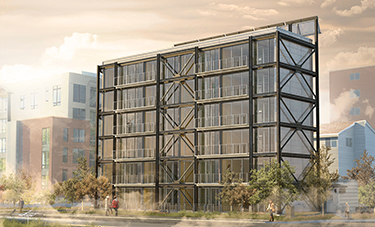|
Subscribe / Renew |
|
|
Contact Us |
|
| ► Subscribe to our Free Weekly Newsletter | |
| home | Welcome, sign in or click here to subscribe. | login |
Architecture & Engineering
| |
 |
October 30, 2014
Survey: CollinsWoerman
Specialty: Commercial, mixed-use, healthcare, multifamily/residential, and science and technology design; interior design; urban planning and design
Management: Arlan Collins, principal; Mark Woerman, principal; Phil Giuntoli, healthcare principal; Steve Moddemeyer, sustainability and urban planning principal
Founded: 1988
Headquarters: Seattle
2014 revenues: N/A
Projected 2015 revenues: 20 percent increase over 2014
Projects: 47+7 Apartments in Seattle, a six-story modular building; Urban Union, a 12-story office building in Seattle’s South Lake Union neighborhood; MultiCare Covington Hospital 58-bed surgical specialty hospital addition
Principal Mark Woerman answered questions about the apartment boom and rising costs.
Q: Seattle has had an apartment boom. What is the next hot sector?
A: Increased national and international investment in the region means that all sectors (commercial, residential, retail) are gaining traction.
We are already seeing increased demand for office space for the technology sector. Larger firms like Amazon and Google are creating new experiential campuses in the urban cores of Seattle and Bellevue, but smaller start-ups are also looking for spaces that promote creativity and collaboration.
To date, a lack of financing and onerous state laws regarding the construction of condominiums has limited the supply of new vertical for-sale product that has created a pent-up demand for that type of housing. This will drive the market’s response for several years and condominiums being converted from apartments will likely be the first wave in the market. Beyond the rush to be first to market, conversions also can mitigate the liability typically associated with the development of new condominium product.
Also, the proliferation of online shopping is redefining the retail market. Destination or experience-driven retail environments are the wave of the future. As retailers integrate entertainment and interactive experiences into their retail environments, developers are converting existing properties or building new amenities to better accommodate new features.
Q: How will rising land and construction costs affect downtown developments?
A: As construction and land development costs increase, they are passed along to the consumer at every level in the form of increased rents, operating costs and expenses that ultimately either drives up wages or forces workers farther from the urban centers. In addition to rising land and construction costs are the ever-increasing costs imposed by city, county and state governments for basic services, infrastructure, affordable housing, and transportation in the form of fees, charges, etc. All of these combine to broaden the gap between those who can afford to live and work close-in and those who cannot.
Q: What are clients/customers asking for now versus five or 10 years ago?
A: The market is already responding to a critical need for market-rate housing for employees in the technology and professional services sectors. However, in general there is an increased demand for properties with integrated technology; convenient access to entertainment and transportation options; sustainability initiatives and materials; and access to social interfaces and opportunities.
Q: What is Sustainable Living Innovations and how are sales going?
A: Sustainable Living Innovations LLC is a building technology developed by CollinsWoerman that developers can use to build multifamily housing projects more quickly and more sustainably than typical residential construction. CollinsWoerman exclusively licenses its patented SLI technology to North American developers and deploys SLI internationally via its Innovative Building Technologies LLC joint venture with Intellectual Ventures.
SLI has a number of projects in advanced negotiations ranging from eight to 30 stories in Seattle, San Francisco, Anchorage and Williston, North Dakota, totaling 1,500 units. We are also actively pursuing projects in New York, Los Angeles, San Diego and Las Vegas.
The SLI technology blends the flexibility of “kit-of-parts” components with modular construction. The building systems — pre-wired and pre-plumbed wall and floor panels, cabinets and roof panels — can be assembled locally and connected at the construction site to the structural frame with bolts. The electrical and plumbing contains “quick connects” between panels for ease of assembly. Due to its simplified technology, interior finish packages are installed on the lower levels as the shell of the building is being completed on the upper levels.
In Seattle’s University District, SLI has a pilot 24-unit apartment project called 47+7 under construction. Each floor of the six-story building is estimated to take a week to complete. The project is slated to be done in December.
Q: Tell us about your joint venture with Intellectual Ventures. Is the technology being used now?
A: Our joint venture — called Innovative Building Technologies LLC (IBT) — was announced in September. IBT’s purpose is to commercialize new inventions for the design and construction of mid- and high-rise housing from a kit of prefabricated component parts. Sustainable Living Innovations LLC has the exclusive license to deploy the technology in the North American market. The first project using the IBT technology is the 24-unit apartment building mentioned above.
Other Stories:
- 5 tools needed to run successful meetings
- Survey: Magnusson Klemencic Associates
- Survey: PCS Structural Solutions
- Survey: Graphite Design Group
- Survey: Notkin Mechanical Engineers
- Survey: Walker Macy
- Survey: Callison
- Energy-efficient design goes to school
- Is Seattle’s housing market falling into the ‘San Francisco Death Spiral’?
- Lean design shines in tricky healthcare projects
- Commissioning is key to a smooth running central utility plant
- Electronic data loss can become a shocking surprise
- D/B competitions: a high-stakes poker game you can’t win
- Why tomorrow’s engineer needs a different education
- Survey: Driftmier Architects



